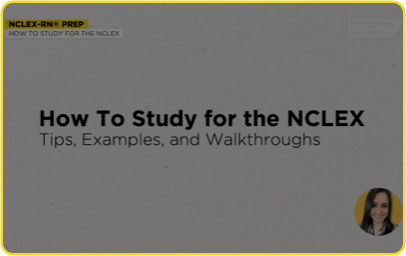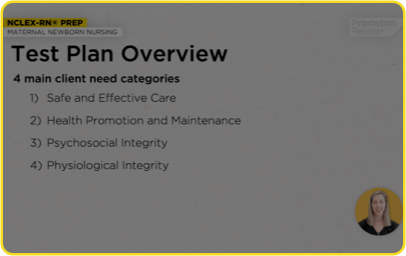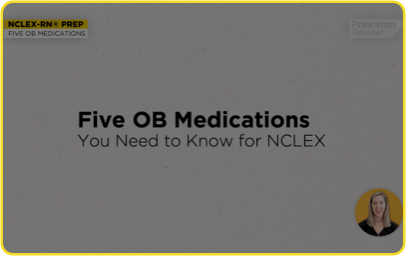12 Sample Questions From our NCLEX-RN QBank
Click below to see if you can
figure out these 12 easy questions
Start Quiz
1. The nurse is planning care for a group of assigned clients. Which client should the nurse implement the sequential compression device?
A. The client who is postoperative day 2 abdominal surgery.
B. The client who had a stroke with paralysis of the left leg.
C. The client with pneumonia who sits up to the chair for meals.
D. The client with gastrointestinal infection who uses a bedside commode.
Next
2. The nurse is caring for a client who is experiencing alcohol withdrawal. The nurse notes the client has tremors in the upper extremities, hyperactive deep tendon reflexes, and a change in mental status. The nurse should assess the client for which electrolyte imbalance?
A. Hypocalcemia
B. Hyponatremia
C. Hypokalemia
D. Hypomagnesemia
Back
Next
3. The nurse is monitoring a client who is receiving an infusion of prescribed packed red blood cells. Which finding reported by the client would indicate to the nurse the client is experiencing a hemolytic transfusion reaction?
A. back pain.
B. shortness of breath.
C. development of hives.
C. malaise.
Back
Next
4. The nurse is teaching a client who is preoperative about how to cough effectively after surgery. Which information should the nurse include in the teaching?
A. “Hold a pillow or folded bath blanket over the incision.”
B. “Get up and walk before you try to cough.”
C. “It would be best if you only cough when you are not in pain.”
C. “When you cough, cover your nose and mouth with a tissue.”
Back
Next
5. A nurse is providing discharge teaching for a client who is prescribed home oxygen therapy. Which statement made by the client indicates to the nurse that further teaching is required?
A. “I should wash the prongs on the cannula with liquid soap at least once a week.”
B. “If I get a cold, I will replace the nasal cannula when I recover.”
C. “My family can smoke in the house, as long as they stay in another room.”
D. “I will use blankets that are made of cotton.”
Back
Next
6. The nurse is caring for a client who reports dyspnea on exertion. Which of the following diagnostic tests should the nurse anticipate for this client to confirm a diagnosis of pulmonary hypertension?
A. echocardiogram
B. chest x-ray
C. right sided heart catheterization
D. computerized tomography scan
Back
Next
7. The nurse is assessing a client diagnosed with severe anemia. Which finding should the nurse expect?
A. BP 146/88
B. Heart rate 125
C. Weight gain
D. Pink conjunctivae
Back
Next
8. The nurse is monitoring a client who is postoperative 6 days following a single-lung transplantation. Which of the following findings should the nurse report to the healthcare provider immediately?
A. client reports incisional pain
B. diminished breath sounds
C. oxygen desaturation with ambulation
D. serosanguinous drainage observed on dressing
Back
Next
9. The nurse is preparing to administer a prescribed dose of lactulose to a client who has cirrhosis. Which lab value will the nurse monitor to evaluate the therapeutic effect of the medication?
A. glucose
B. ammonia
C. potassium
D. bicarbonate
Back
Next
10. The nurse is caring for a client with acute appendicitis. Which finding should the nurse immediately report to the healthcare provider?
A. febrile
B. diarrhea
C. sudden decrease in abdominal pain
D. positive Kernig’s sign
Back
Next
11. The home health nurse is reviewing the daily blood glucose levels of a client with diabetes type 1 who receives prescribed NPH insulin morning and evenings and lispro sliding scale with meals. The nurse notes the client experiences hyperglycemia daily at 6am. Which action would be the best for the nurse to take?
A. Obtain a prescription to increase the evening mealtime dose of prescribed NPH insulin.
B.Instruct the client to check the blood glucose level at 2am and record results for one week.
C. Encourage the client to eat a snack with 30 grams of carbohydrates before bed.
D. Advise the client to check blood glucose levels 2 hours after waking up.
Back
Next
12. The nurse is assessing a client with myasthenia gravis and notes that the client’s respiratory rate is 10 and there is limited chest wall movement. Which of the following interventions should the nurse take?
A. Prepare the client for mechanical ventilation.
B. Administer a prescribed anticholinesterase medication.
C. Instruct the client on pursed-lip breathing.
D. Position the client in high-Fowler’s.
Back
Submit
You got out of 12 correct.
You are on your way, but practice makes perfect!
Great job! You have enough fundamental knowledge to start prepping for the NCLEX-RN exam.
Solutions
Question 1
Amanda Blue, nclex-rn®, is explaining to a group of students the difference between ethical conduct and legal requirements. Which of the following statements would Blue most likely make to the students:
-
A. The client who is postoperative day 2 abdominal surgery.
-
B. The client who had a stroke with paralysis of the left leg.
-
C. The client with pneumonia who sits up to the chair for meals.
-
D. The client with gastrointestinal infection who uses a bedside commode.
Solution:
Rationale: Sequential compression device is used to promote venous return which will decrease the risk of developing a deep vein thrombosis. The nurse should implement the sequential compression device for the client who has impaired mobility, resulting in the inability to ambulate. The client who had a stroke with paralysis of the left leg is the highest risk for developing a DVT. The client who is postoperative 2 days, the client with pneumonia and the client with gastrointestinal infection are ambulatory.
Client Needs: Basic Care and Comfort
Question 2
The nurse is caring for a client who is experiencing alcohol withdrawal. The nurse notes the client has tremors in the upper extremities, hyperactive deep tendon reflexes, and a change in mental status. The nurse should assess the client for which electrolyte imbalance?
-
A. Hypocalcemia
-
B. Hyponatremia
-
C. Hypokalemia
-
D. Hypomagnesemia
Rationale: Clients who are experiencing alcohol withdrawal are at risk of developing hypomagnesemia. The client will exhibit tremors, muscle weakness, change in mental status, and hyperactive deep tendon reflexes. The nurse should obtain a serum hypomagnesemia level. Clients with inadequate calcium intake can develop hypocalcemia. Clients with vomiting or diarrhea or taking prescribed diuretics can develop hypokalemia. Hyponatremia develops from an excessive gain of water.
Client Needs: Physiological Adaptation
Question 3
The nurse is monitoring a client who is receiving an infusion of prescribed packed red blood cells. Which finding reported by the client would indicate to the nurse the client is experiencing a hemolytic transfusion reaction?
-
A. back pain.
-
B. shortness of breath.
-
C. development of hives
-
D. malaise
Solution:
Rationale: A hemolytic transfusion reaction occurs when the blood product is incompatible. The client with a hemolytic transfusion reaction will report back pain, headache, facial flushing, and will become febrile. Clients with an allergic reaction to the blood products will develop hives, shortness of breath. Malaise is often associated with a febrile reaction.
Client Needs: Pharmacological and Parenteral Therapies
Question 4
The nurse is teaching a client who is preoperative about how to cough effectively after surgery. Which information should the nurse include in the teaching?
-
A. “Hold a pillow or folded bath blanket over the incision.”
-
B. “Get up and walk before you try to cough.”
-
C. “It would be best if you only cough when you are not in pain.”
-
D. “When you cough, cover your nose and mouth with a tissue.”
Solution:
Rationale: Because postoperative coughing is often painful, the patient should be taught how to splint the incision by supporting it with a pillow or folded bath blanket.
Client Needs: Basic Care and Comfort
Question 5
A nurse is providing discharge teaching for a client who is prescribed home oxygen therapy. Which statement made by the client indicates to the nurse that further teaching is required?
-
A. “I should wash the prongs on the cannula with liquid soap at least once a week.”
-
B. “If I get a cold, I will replace the nasal cannula when I recover.”
-
C. “My family can smoke in the house, as long as they stay in another room.”
-
D. “I will use blankets that are made of cotton.”
Solution:
Rationale: Clients who are prescribed home oxygen should be taught how to prevent infection and injury. Clients should be instructed to wash the prongs on the cannula with liquid soap, rinsing thoroughly at least once a week and to change the nasal cannula if they have been sick. Blankets made with wool or synthetic fibers can carry a static charge, which could increase the risk of fire. Clients should instruct all family members and guests not to smoke in the house.
Client Needs: Safety and Infection Control
Question 6
The nurse is caring for a client who reports dyspnea on exertion. Which of the following diagnostic tests should the nurse anticipate for this client to confirm a diagnosis of pulmonary hypertension?
-
A. echocardiogram
-
B. chest x-ray
-
C. right sided heart catheterization
-
D. computerized tomography scan
Solution:
Rationale: Pulmonary hypertension is elevated pulmonary artery pressures due to an increase in resistance of blood flow through the pulmonary vasculature, which can lead to right-sided heart failure. A right-sided heart catheterization is the diagnostic test to confirm the diagnosis of pulmonary hypertension. The other options can provide information about the structure of the heart and lungs but cannot measure the pulmonary artery pressures.
Client Needs: Physiological Adaptation
Question 7
The nurse is assessing a client diagnosed with severe anemia. Which finding should the nurse expect?
-
A. BP 146/88
-
B. Heart rate 125
-
C. Weight gain
-
D. Pink conjunctivae
Solution:
Rationale: When there are fewer red blood cells, there is less hemoglobin and less oxygen. Therefore, clients with severe anemia have tachycardia as a compensatory mechanism to increase cardiac output. The other options are incorrect because clients with anemia are often pale in color, lose weight, and may be hypotensive because of decreased cardiac output.
Client Needs: Physiological Adaptation
Question 8
The nurse is monitoring a client who is postoperative 6 days following a single-lung transplantation. Which of the following findings should the nurse report to the healthcare provider immediately?
-
A. client reports incisional pain
-
B. diminished breath sounds
-
C. oxygen desaturation with ambulation
-
D. serosanguinous drainage observed on dressing
Solution:
Rationale: The client who is postoperative single-lung transplantation is at risk for acute rejection which can occur in the first 10 days. The nurse should monitor the client for oxygen desaturation, low grade fever, dyspnea with exertion, and a dry cough. The other options are normal findings following lung surgery.
Client Needs: Reduction of Risk Potential
Question 9
The nurse is preparing to administer a prescribed dose of lactulose to a client who has cirrhosis. Which lab value will the nurse monitor to evaluate the therapeutic effect of the medication?
-
A. glucose
-
B. ammonia
-
C. potassium
-
D. bicarbonate
Solution:
Rationale: Hepatic encephalopathy is a manifestation of liver disease that has neurotoxic effects of ammonia. Lactulose acidifies feces in the intestines which traps ammonia that can be then eliminated with defecation.
Client Needs: Pharmacological and Parenteral Therapies
Question 10
The nurse is caring for a client with acute appendicitis. Which finding should the nurse immediately report to the healthcare provider?
-
A. febrile
-
B. diarrhea
-
C. sudden decrease in abdominal pain
-
D. positive Kernig’s sign
Solution:
Rationale: When caring for a client with acute appendicitis, the nurse should monitor the client for potential complications, including rupture of the appendix. Sudden decrease in abdominal pain is a manifestation of a ruptured appendix and requires immediate surgical intervention. Diarrhea, febrile, and positive Kernig’s sign are expected manifestations of acute appendicitis.
Client Needs: Physiological Adaptation
Question 11
The home health nurse is reviewing the daily blood glucose levels of a client with diabetes type 1 who receives prescribed NPH insulin morning and evenings and lispro sliding scale with meals. The nurse notes the client experiences hyperglycemia daily at 6am. Which action would be the best for the nurse to take?
-
A. Obtain a prescription to increase the evening mealtime dose of prescribed NPH insulin.
-
B. Instruct the client to check the blood glucose level at 2am and record results for one week.
-
C. Encourage the client to eat a snack with 30 grams of carbohydrates before bed.
-
D. Advise the client to check blood glucose levels 2 hours after waking up.
Solution:
Rationale: A client with diabetes type I who is experiencing hyperglycemia at 6 am might be experiencing dawn phenomenon or the Somogyi effect. To identify the cause of the hyperglycemia, the nurse should instruct the client to check blood glucose levels at 2am for one week. If the client is experiencing dawn phenomenon, then the client would require an increase in evening dose of prescribed NPH insulin. If the client is experiencing Somogyi effect, the client should be instructed to eat a bedtime snack with 30 grams of carbohydrates. The client should check the blood glucose before meals.
Client Needs: Physiological Adaptation
Question 12
The nurse is assessing a client with myasthenia gravis and notes that the client’s respiratory rate is 10 and there is limited chest wall movement. Which of the following interventions should the nurse take?
-
A. Prepare the client for mechanical ventilation.
-
B. Administer a prescribed anticholinesterase medication.
-
C. Instruct the client on pursed-lip breathing.
-
D. Position the client in high-Fowler’s.



